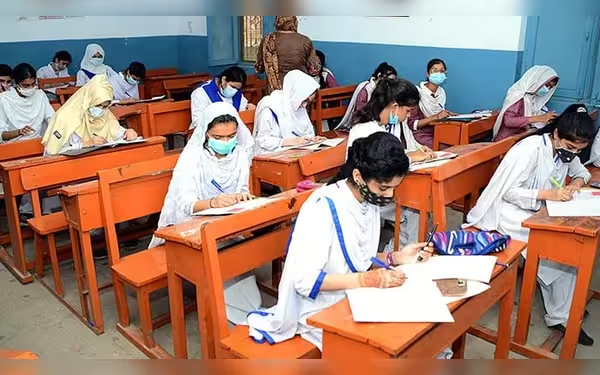Saturday, November 16, 2024 09:48 PM
Sindh Education System Fails to Utilize $75 Million Funding
- Sindh government misallocates $75 million education funds.
- OMR machine procurement remains unfulfilled despite claims.
- Critics highlight deteriorating educational quality in Sindh.
 Image Credits: geo
Image Credits: geoSindh's education system struggles to utilize $75 million funding, raising concerns over priorities and effectiveness in improving educational quality.
The education system in Sindh has been under scrutiny for years, and recent developments have only intensified the focus on its shortcomings. Despite securing a substantial $75 million in external funding aimed at improving secondary education, the Sindh government has yet to establish an effective mechanism to utilize these funds. This situation raises serious questions about the priorities of the provincial government and its commitment to educational reform.
Pakistan's educational landscape has long been criticized for failing to nurture extraordinary talent. The root of the problem lies not in the intellect of the students but in a rigid educational structure that stifles creativity. The manual grading system, which often favors those with money and power, has been a significant barrier to progress. Cheating scandals and a lack of transparency in exam marking have created an environment ripe for corruption, undermining the integrity of the education system.
In 2020, the Sindh government entered into a loan agreement with the Asian Development Bank (ADB) under the Sindh Secondary Education Improvement Project (SSEIP). The primary objectives of this $75 million loan included constructing 160 new educational blocks, training teachers in science subjects, and transitioning from a manual grading system to an automated one using Optical Marking Recognition (OMR) machines. The intention was to minimize human intervention in the grading process, thereby enhancing fairness and accuracy.
However, a closer examination of the project's implementation reveals a troubling trend. Reports indicate that a significant portion of the funds has been diverted to salaries and operational costs rather than being allocated to the intended educational improvements. In a briefing session held in June 2023, the Sindh government claimed that procurement for OMR machines had been completed, yet the contract for these machines remains active and unfulfilled. Furthermore, while the government announced the distribution of lab equipment to 400 schools, procurement reports only confirm the delivery to 100 schools under the Sindh Education Foundation.
According to the budget for 2024-25, the total estimated expenditure on the SSEIP is a mere Rs225 million, which many experts deem insufficient for meaningful change. Former provincial assembly member Rabia Nizami, who was part of the Steering Committee of Education, expressed her concerns in an open letter to the ADB. She stated, "This project was supposed to transform the whole ecosystem of the secondary grading system, but it's on a halt because it is not the priority of the Sindh government." Nizami emphasized that without a comprehensive overhaul of the educational structure, the introduction of OMR machines would be ineffective.
In response to the criticisms, Sindh Minister for Boards and Universities, Mohammad Ali Malkani, assured that OMR machines have been procured and distributed across the province. He stated, "From next year, we will be implementing an automated grading system and OMR sheets in Sindh." However, when questioned about the delays, he attributed the issue to the Ministry of Education and Literacy, raising further concerns about accountability.
Critics, including former president of the Institute of Cost and Management Accountants of Pakistan, Hasan Bilgrami, have pointed out the deteriorating quality of education in Sindh. He remarked, "The education in Sindh has no sanctity left. The input has no quality because of the current educational structure." The recent decision by the Karachi board to reduce the percentage of Second Year students without explanation exemplifies the chaos within the system.
Feroz-Uddin Ahmed, former president of the Sindh Professors and Lecturers Association, noted that while the SSEIP project is now in its second phase, the implementation of e-marking systems remains limited. He expressed hope for broader adoption of OMR and e-marking technologies, stating, "OMR or e-marking would be fruitful for the future of students across Sindh and it would definitely help in advancing education."
As it stands, Sindh continues to rank among the lowest in educational performance across Pakistan. The District Index report released by the Planning and Commission department highlights several districts in Sindh lagging behind in critical indicators such as infrastructure and educational quality. The situation in Malkani's district, Sujawal, is particularly concerning, reflecting the urgent need for reform.
The $75 million funding intended to uplift Sindh's education system has yet to yield tangible results. The lack of effective implementation and prioritization by the provincial government raises serious concerns about the future of education in the region. For real change to occur, a commitment to transparency, accountability, and a genuine overhaul of the educational structure is essential. Only then can the potential of Sindh's youth be fully realized, paving the way for a brighter future for the province and the nation as a whole.













